Finding the best spot for your TV can totally change how you enjoy your living space. Where you put it affects your viewing experience, but also how your room feels and works day to day.
Remember to repin your favorite images!
The perfect TV placement strikes that balance between comfort and the layout or style of your room.
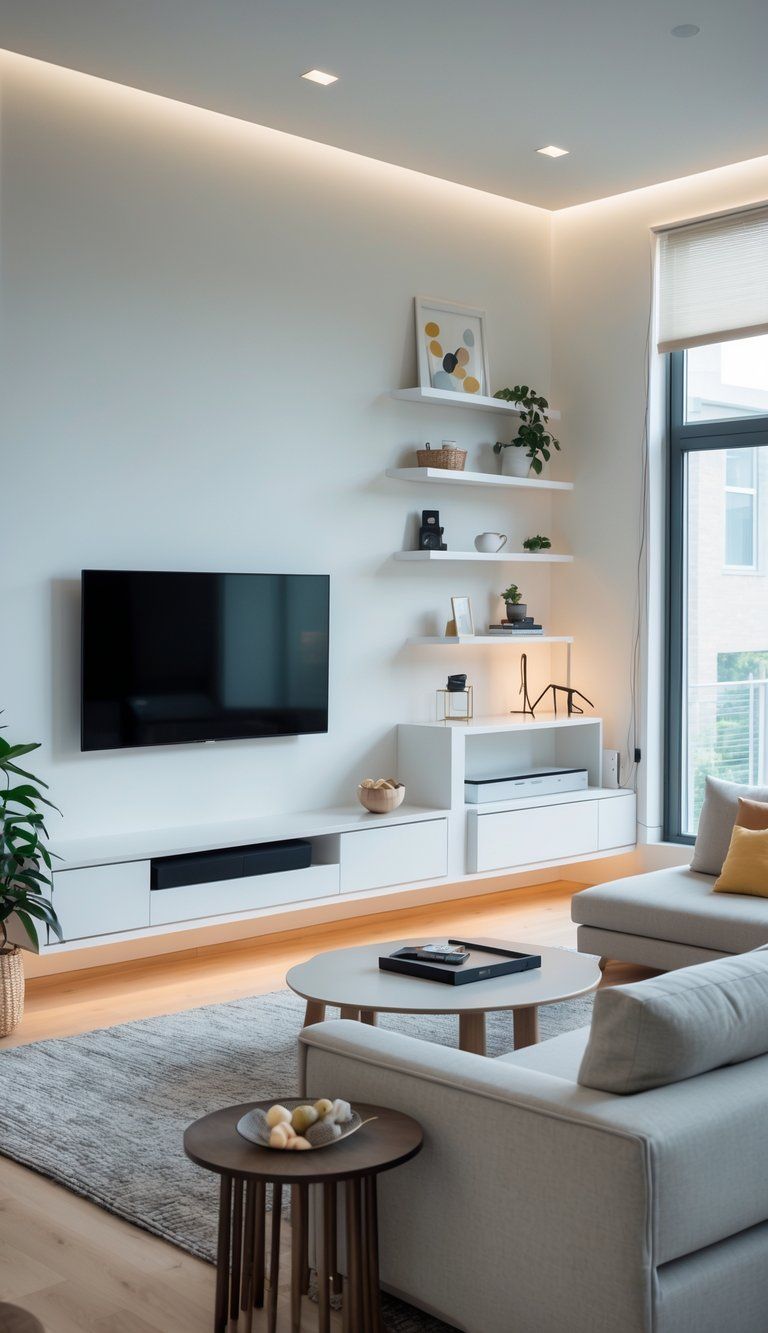
Every home has its own TV placement challenges. Some rooms have weird angles. Others? Big windows that throw glare everywhere.
Your TV could hang on a wall, tuck into an alcove, or sit on a cool media console. It really depends on your space and what you want out of it.
Room size plays a big part too. In bigger rooms, you’ll want furniture that feels in scale so your TV doesn’t look lost. For smaller spaces, you can get creative—maybe sideways placement in a unit or a floating entertainment center. These save floor space and keep your TV front and center without clashing with your decor.
Foundations of the Perfect TV Placement
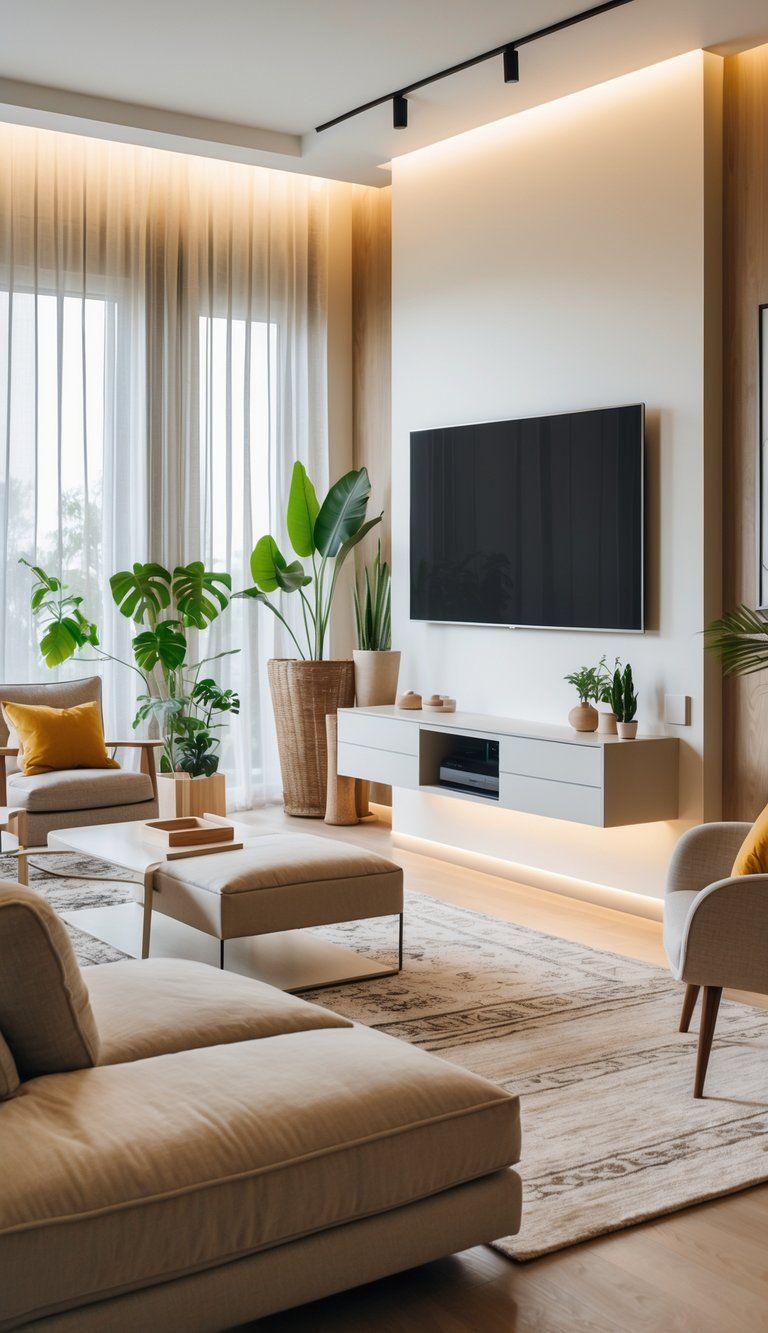
Finding the right TV spot changes both your viewing and your room’s vibe. The best placement takes eye level, room layout, and how the TV fits with your decor into account.
Key Factors in Optimal TV Placement
Eye level is huge. When you’re sitting, your eyes should land in the middle of the screen. This saves your neck during those long binge sessions.
Distance matters, too. Try sitting about 1.5 to 2.5 times your TV’s diagonal size away from the screen. For a 55-inch TV, that’s roughly 7 to 11 feet.
Some key things to keep in mind:
- Viewing angle: Keep your TV straight on from your main seat
- Lighting: Dodge glare from windows or lamps
- Height: Center the screen at your eye level when sitting
- Room traffic: Don’t put the TV where people walk in front of it
Let your room’s size guide your TV size and where you put it. In tight spots, wall mounting can really free up space.
Balancing Viewing Experience With Room Functionality
Your TV shouldn’t take over every activity in the room. Think about what else happens there.
In living rooms, arrange furniture so people can talk and not just stare at the screen. Not every chair has to face the TV.
Try flexible solutions:
- Swivel mounts so you can change the angle
- Cabinet doors to hide the screen when you’re not watching
- Room dividers to split up the space
Pay attention to how people move through the room. Place your TV so it’s not in the way or creating awkward bottlenecks. Open-concept homes especially need this.
Tech should make life easier, not messier. Tidy up those cables and make sure you can reach outlets without cords running everywhere.
Integrating TV Placement Into Interior Design
TVs aren’t just boxes anymore—they can be part of your design. Build a gallery wall with art and photos around your TV. It helps the screen blend in when it’s off.
Wall color can affect how your eyes feel. Medium tones behind the TV are easier on the eyes than bright white or super dark colors.
Built-ins look awesome:
- Custom media walls with shelves
- Alcoves that frame the TV
- Furniture designed for your devices
Don’t forget the extras. Sound bars, consoles, streaming gadgets—they all need homes. Plan for them early so you don’t end up with a mess later.
Scale is important. A tiny TV on a huge wall looks odd, and a massive screen can swallow a small room. Try to keep things in proportion with your furniture and wall space.
TV Placement Solutions for the Living Room
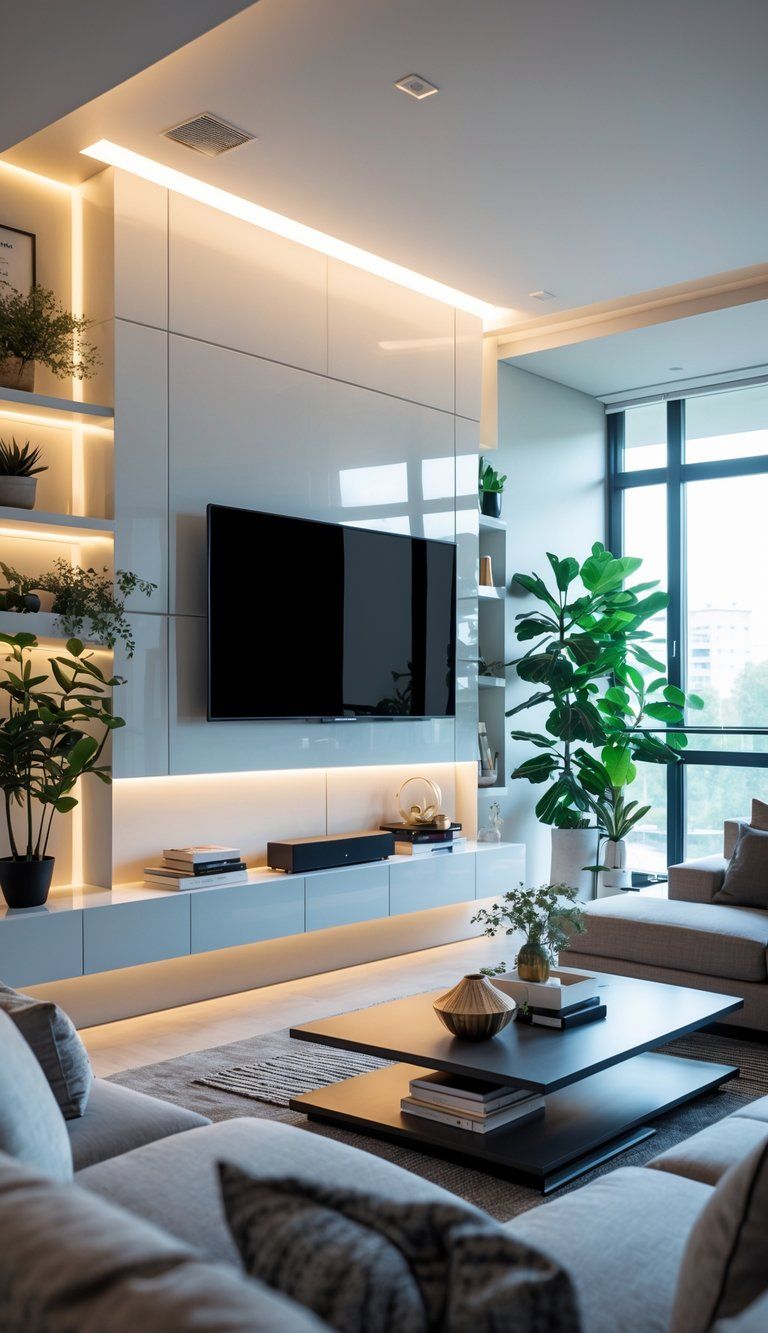
The living room is usually where the TV action happens. Where you put it can really affect comfort, how you watch, and your whole room’s feel.
Choosing the Ideal Wall and Viewing Distance
Pick a wall that doesn’t face windows to avoid glare. Above the fireplace is a classic move—it saves space and creates a focal point. Just check the height so you don’t end up craning your neck.
For distance, divide your TV’s size by 0.55 to get the ideal spot in inches. So, a 55-inch TV is best about 100 inches (8.3 feet) away.
Quick Distance Guide:
- 43″ TV: 6-7 feet away
- 55″ TV: 7-9 feet away
- 65″ TV: 9-10.5 feet away
- 75″ TV: 10.5-12 feet away
Working With Living Room Layouts and Furniture Design
Make your seating work with your TV. If you can, have your main sofa face the TV. For L-shaped layouts, position the TV so both sections get a good view.
In open spaces, use furniture to define the TV zone. Sectionals or well-placed chairs help create a natural area for watching.
Awkward floor plan? Wall-mounted TVs with adjustable arms give you options. You can pull out and angle the screen for different spots.
Hide cords with cable management—seriously, it makes a big difference in how tidy your room looks.
TV Unit Designs for Modern Living Spaces
Modern TV units aren’t just for holding your screen. They bring storage and style to your living room.
Floating media consoles look sleek and save space, which is perfect for smaller rooms.
Custom cabinetry around your TV creates a built-in look and lots of storage. Cabinets with doors can hide devices when you’re not using them.
If you like things minimal, go for a simple TV stand with clean lines. Look for built-in cable management.
For big screens, make sure your TV unit is wide enough—ideally a few inches wider than your TV on each side for balance.
Designing TV Units and Cabinets
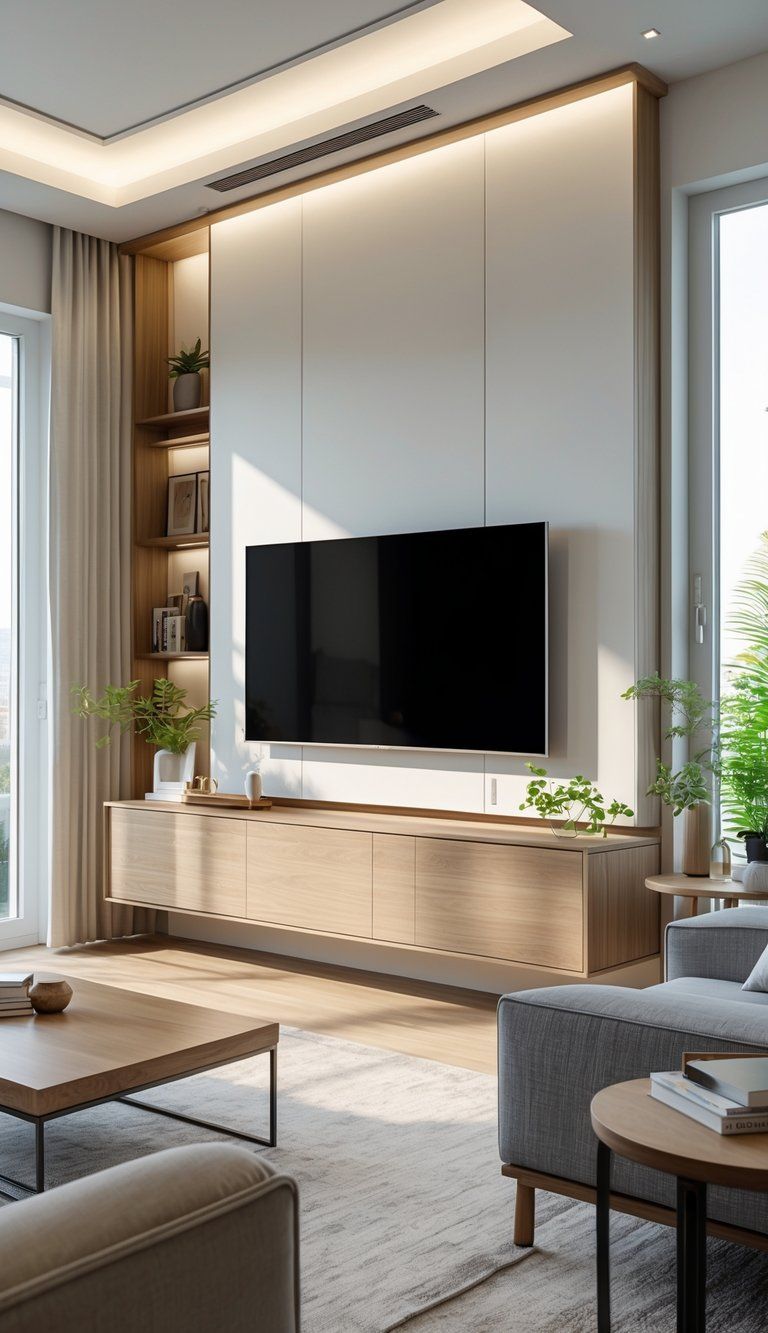
The right TV unit or cabinet does more than just hold your television. It becomes a focal point and adds storage that actually works.
Modern TV Cabinet Options
Today’s TV cabinets are super versatile. Wall-mounted units create that floating effect and free up floor space, giving your room a modern vibe. Built-in cable management keeps wires out of sight.
Floor-standing cabinets add more storage with drawers and shelves for your devices and games. Many modern options have push-to-open doors, so you don’t see handles everywhere.
Tech lovers can find smart TV units with built-in lighting, wireless charging, or even sound systems. Some cabinets now include all that in one design.
You’ll see materials from high-gloss finishes to textured surfaces. Mixing materials—like wood and metal—adds drama and makes your TV area pop.
Incorporating Clean Lines and Natural Materials
Clean lines make TV units look fresh and simple. Cabinets with geometric shapes and minimal details keep things timeless.
Natural materials like solid wood bring in warmth. Oak, walnut, or teak add texture and last for ages. Designers often mix wood with metal frames for a cool, industrial twist.
Try these combos:
- Light wood with black metal
- Stone veneer with glass shelves
- Bamboo with brass hardware
Eco-friendly options like reclaimed wood or bamboo give you style and sustainability. They age well and add character.
Integrated lighting in shelves can highlight your favorite objects and set the mood. LED strips behind the TV help your eyes during late-night movies.
Customisation for Unique Spaces
Custom TV units solve weird room layouts and storage problems. Built-ins can turn awkward corners or alcoves into useful spots.
Consider these custom options:
- Modular pieces you can add to over time
- Adjustable shelves for all your gadgets
- Drawers with dividers for media
- Hidden compartments for things you want close but not visible
In small rooms, multi-functional units that double as a desk or dining space are a lifesaver. Some even have fold-down desks or rotating mounts for flexibility.
Match the unit’s dimensions to your TV. Leave about 6 inches of space on each side of the screen for balance. The center of your TV should be at eye level when you’re sitting down.
Enhancing Aesthetic Appeal and Integration
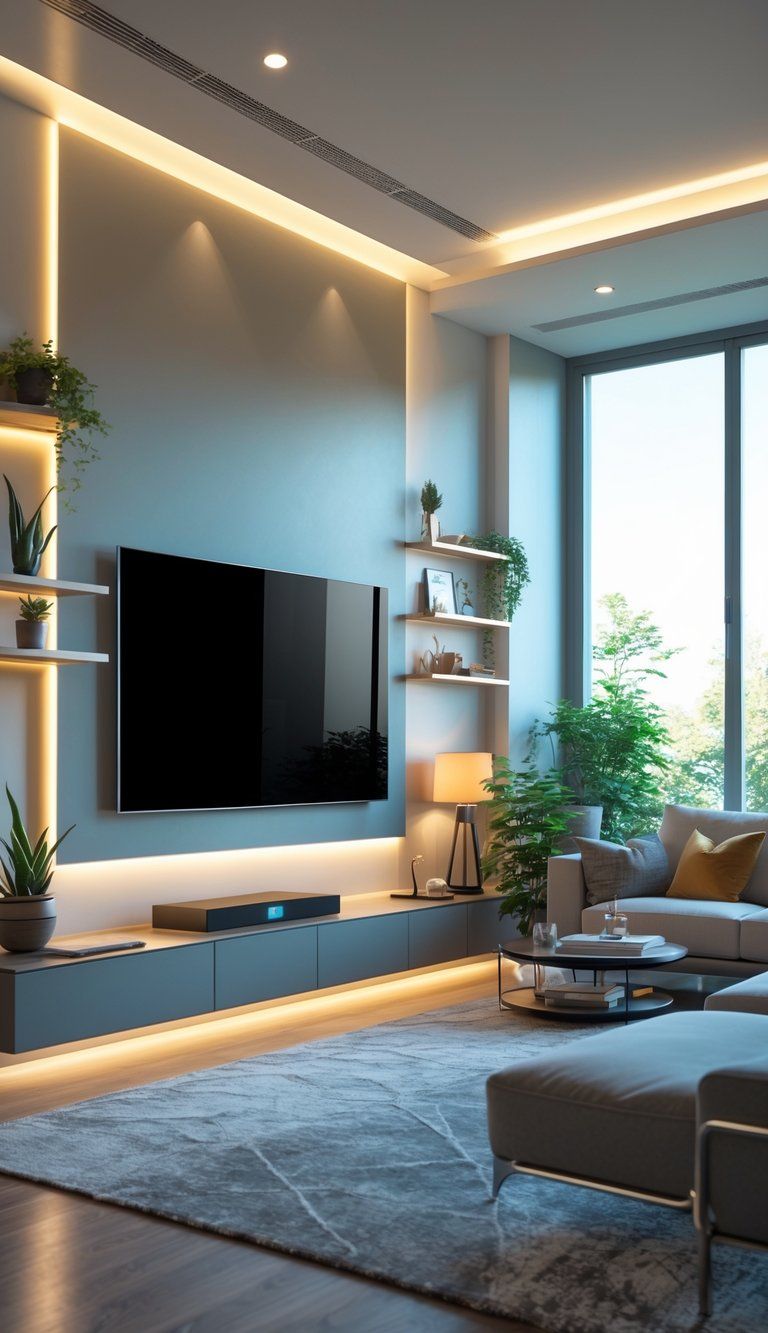
TV placement doesn’t have to mess up your style. With a little planning, your TV can actually add to your decor.
Seamlessly Blending TVs With Gallery Walls
Gallery walls are a clever way to hide your TV and show off your personality. Pick frames in colors and sizes that work together and arrange them around your TV.
Keep things balanced—spread out the bigger pieces and keep your TV at eye level, usually about 42-48 inches from the floor. That way, it’s comfy to watch and looks right.
Frame TVs that display art when they’re off are a game-changer. They blend right in with your other artwork, so your TV disappears until you want it.
Stick to similar frame styles or a cohesive color palette for a pulled-together look. Black-and-white photos are a classic choice and won’t fight with your TV.
Maximizing Spaciousness and Visual Balance
Smart TV placement can make your room feel bigger and more balanced. Mount your TV on the wall to open up floor space and keep things neat.
Arrange your furniture so there’s a comfy viewing distance—about 1.5 times your TV’s diagonal size—while leaving clear walkways.
Built-ins like recessed nooks or custom cabinets let your TV disappear when you’re not watching. These add interest and keep your space open.
Use lighting that you can adjust. Brighten things up for daily use, then dim them for movie nights. Avoid putting lights right across from your screen to cut down on glare.
Match your TV’s size to your furniture. A giant TV over a tiny console looks off, but with the right proportions, everything feels harmonious.
Smart Technology and Cable Management
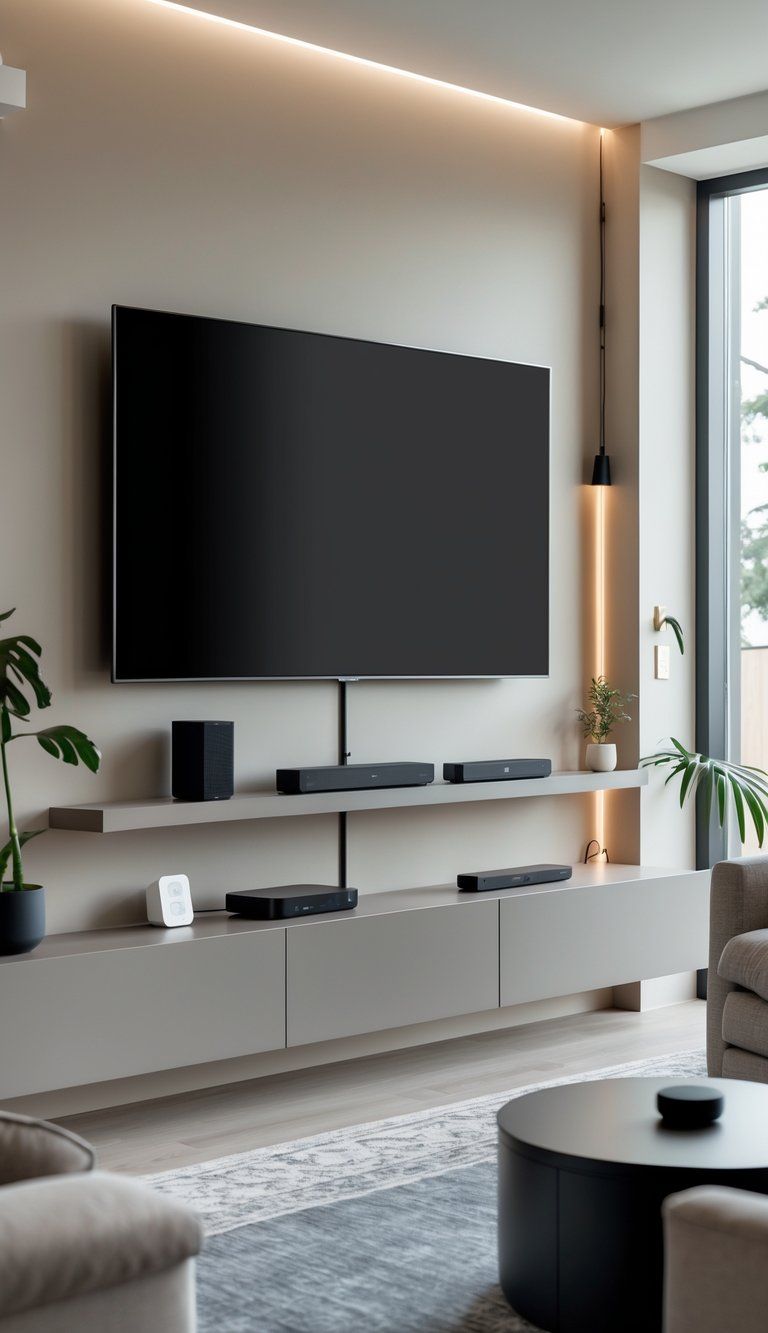
Home entertainment setups now mix sleek TVs with tons of devices. Getting them to work together—and hiding the cables—makes any room look way better.
Choosing Smart TVs and Connected Devices
When you’re picking a smart TV, check if it works with your current devices. Most new smart TVs connect to Wi-Fi and have apps like Netflix and Hulu built in.
Look for TVs with voice assistants like Google Assistant or Alexa. You can control your TV and other smart home features just by asking.
Count your HDMI ports before you buy. Think about your gaming consoles, sound bars, and streaming devices. Some newer TVs have HDMI 2.1 ports for top-notch gaming and video.
Wireless casting from your phone or tablet can cut down on cables. TVs with Chromecast, AirPlay, or similar options make it easy to share content without plugging in extra stuff.
Advanced Cable Management Solutions
In-wall cable management kits give wall-mounted TVs the cleanest look. You can run cables through the wall between your TV and components, so wires completely disappear from view.
DIY designer Sarah Chen says, “The key to successful TV mounting in small spaces is meticulous cable management. Even the sleekest mounted TV looks cluttered if surrounded by dangling wires.”
If you’re renting and can’t modify the walls, try cord covers that match your wall color. You can paint these channels to blend in, and they attach right to the wall to hide cables inside a slim track.
Cord sleeves and cable ties help bundle multiple wires together. With this quick fix, you turn a mess of cables into one neat unit.
Smart power strips with app control let you pick which devices get power and when. You can save energy and skip crawling behind furniture just to reach an outlet.
TV Placement Strategies for Other Rooms
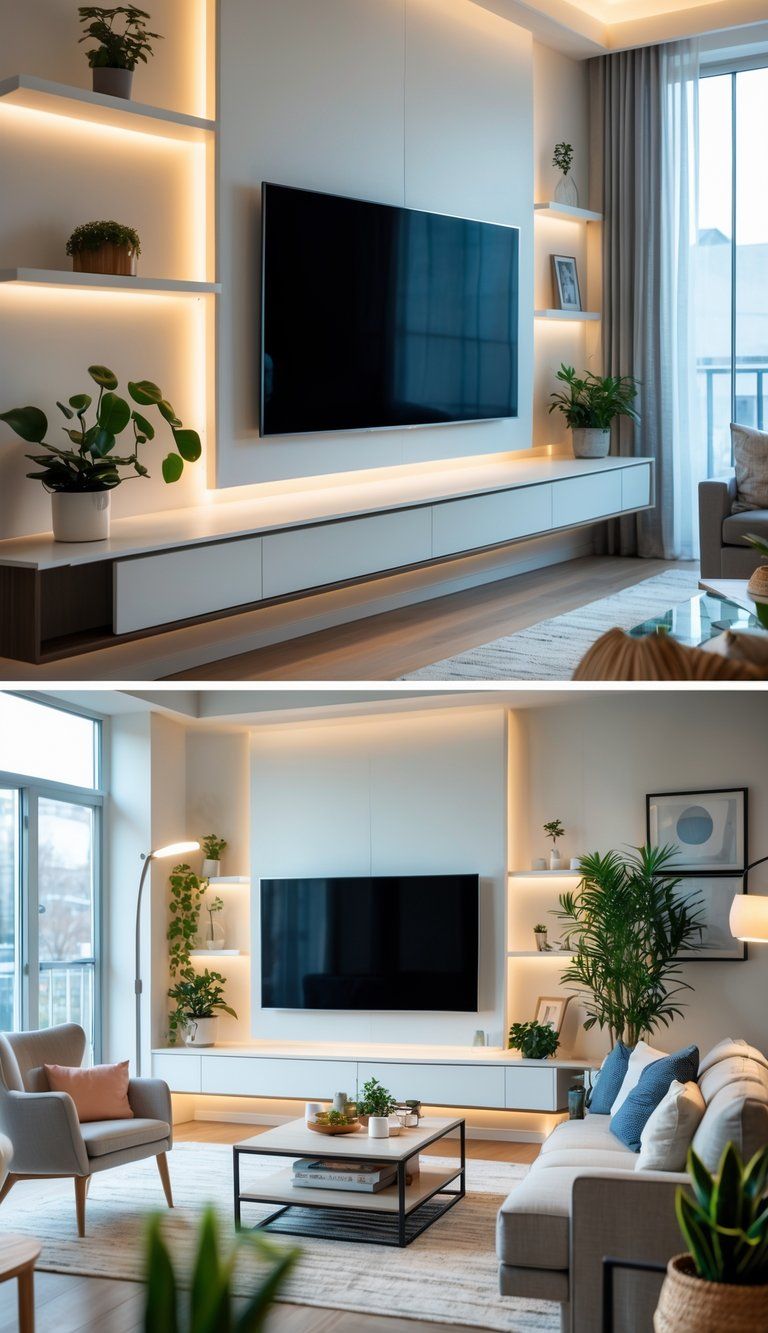
Your TV doesn’t have to live in the living room. It can add something special to other spaces too. The trick is finding a balance between function and design, especially since every room has its own quirks.
Bedroom and Multi-Functional Spaces
In bedrooms, you want to focus on viewing comfort. Try mounting your TV straight across from the bed at eye level when you sit up.
For a 43-50 inch TV in an average bedroom, 7-8 feet is usually the sweet spot for distance.
If you have a guest room or a space that pulls double duty, look at wall-mounting with an adjustable arm bracket. This way, you can:
- Push it flush to the wall when you don’t need it
- Pull it out and swivel for better angles
- Save precious floor space in smaller rooms
Short on space? Set your TV on a dresser or a media cabinet that matches your bedroom furniture. Just check that the height works for watching from bed.
Kitchens, Offices, and Niche Areas
In kitchens, under-cabinet or small wall-mounted TVs work best. Keep them away from heat and water, but make sure you can see the screen while prepping food.
A 24-32 inch TV usually fits kitchens without taking over the room.
For home office setups, place your TV where it won’t distract you while you work. Try a side wall mount or tuck the screen into custom cabinetry for some flexibility between focus and downtime.
Got an unused nook or alcove? Hallways and transition spaces can make great TV spots. A swivel mount lets you catch the screen from different angles as you move through the house.
Wherever you put a TV, run cables through walls or use cord management tricks. Clean lines matter even more in these smaller or less obvious spaces.
Durability, Quality, and Longevity in TV Design Solutions
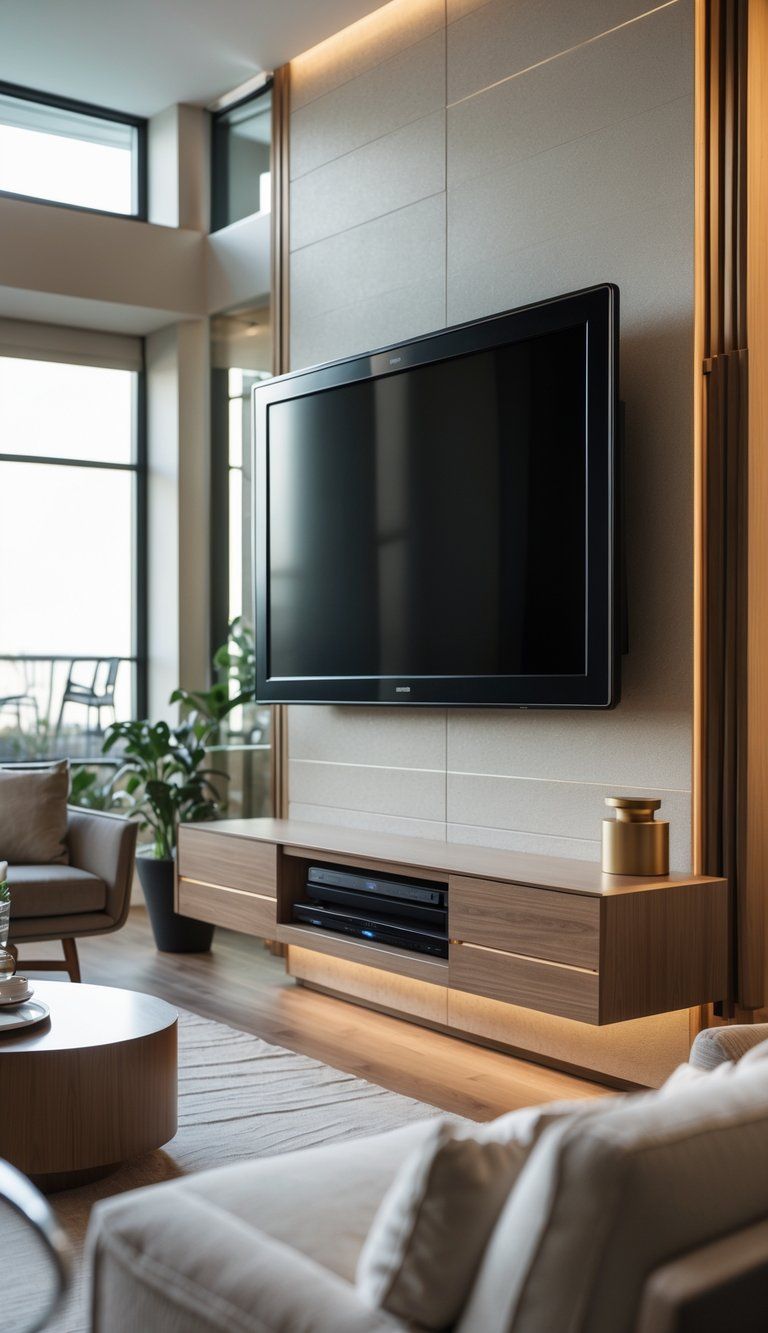
When you invest in a TV setup, you really need to think beyond just the screen. The furniture and mounting gear you pick will affect how long your entertainment system lasts and how well it fits your life.
Choosing Durable Materials and Finishes
Wood is still one of the most reliable choices for TV units. Oak and walnut, in particular, hold up well and resist dents or scratches that cheaper materials just can’t handle.
Metal frames with tempered glass shelving look modern and last longer than you might expect. Go for powder-coated steel to avoid corrosion and keep fingerprints at bay.
If you’ve got kids around, you might want to look for:
- Rounded corners to cut down on injuries
- Scratch-resistant laminates
- Water-resistant finishes to guard against spills
Try to steer clear of particle board units if you can. They usually only last 3-5 years, while solid wood can stick around for 10-15. If you’re on a budget, engineered wood with a good veneer is a decent compromise.
Ensuring Lasting Quality in TV Units
Quality isn’t just about the materials—it’s about how people put everything together. Check for dovetail or mortise and tenon joints instead of just glue and staples.
You’ll probably get way more years out of furniture built with those classic joinery methods.
Built-in cable management makes a real difference. It helps you avoid wire strain and keeps your tech running smoothly.
It’s easy to overlook, but good cable management can save your electronics from early failure.
Think about weight capacity before you buy. Your TV unit needs to hold your current TV, plus about 20% more for future upgrades.
Don’t forget to factor in soundbars or any other components. Maybe you’ll want to add a few decorative items too.
Adjustable shelves give you a lot more flexibility as your setup changes. Fixed shelves? They might force you to swap out the whole unit when you upgrade.
Ventilation matters too. Proper cutouts prevent your devices from overheating and help them last longer.
Aim for units with at least two inches of clearance around vents to keep the air moving.

